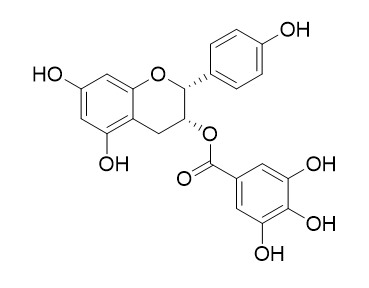(-)-Epiafzelechin 3-O-gallate
(-)-Epiafzelechin 3-O-gallate has antioxidant activity.
Inquire / Order:
manager@chemfaces.com
Technical Inquiries:
service@chemfaces.com
Tel:
+86-27-84237783
Fax:
+86-27-84254680
Address:
1 Building, No. 83, CheCheng Rd., Wuhan Economic and Technological Development Zone, Wuhan, Hubei 430056, PRC
Providing storage is as stated on the product vial and the vial is kept tightly sealed, the product can be stored for up to
24 months(2-8C).
Wherever possible, you should prepare and use solutions on the same day. However, if you need to make up stock solutions in advance, we recommend that you store the solution as aliquots in tightly sealed vials at -20C. Generally, these will be useable for up to two weeks. Before use, and prior to opening the vial we recommend that you allow your product to equilibrate to room temperature for at least 1 hour.
Need more advice on solubility, usage and handling? Please email to: service@chemfaces.com
The packaging of the product may have turned upside down during transportation, resulting in the natural compounds adhering to the neck or cap of the vial. take the vial out of its packaging and gently shake to let the compounds fall to the bottom of the vial. for liquid products, centrifuge at 200-500 RPM to gather the liquid at the bottom of the vial. try to avoid loss or contamination during handling.
Int J Mol Sci.2022, 23(10):5813.
Viruses.2017, 9(10)
Mol Neurobiol.2023, 60(12):7196-7207.
Front Nutr.2023, 10:1181135.
Nutrients.2024, 16(16):2612.
Org Biomol Chem.2017, 15(31):6483-6492
Nanotechnology.2024, ad470d.
Am J Chin Med.2023, 51(4):1019-1039.
Cells.2023, 12(3):395.
VNU J Sci: Med. Pharm. Sci.2024, 40(2):21-30.
Related and Featured Products
Molecules. 2012 Nov 27;17(12):14037-45.
Antioxidant phenolic compounds from Pu-erh tea.[Pubmed:
23187287 ]
METHODS AND RESULTS:
Eight compounds were isolated from the water extract of Pu-erh tea and their structures were elucidated by NMR and MS as gallic acid (1), (+)-catechin (2), (−)-epicatechin (3), (−)-epicatechin-3-O-gallate (4), (−)-epigallocatechin-3-O-gallate (5), (-)-Epiafzelechin 3-O-gallate (6), kaempferol (7), and quercetin (8). Their in vitro antioxidant activities were assessed by the DPPH and ABTS scavenging methods with microplate assays. The relative order of DPPH scavenging capacity for these compounds was compound 8 > compound 7 > compound 1 > compound 6 > compound 4 ≈ compound 5 > compound 2 > VC (reference) > compound 3, and that of ABTS scavenging capacity was compound 1 > compound 2 > compound 7 ≈ compound 8 > compound 6 > compound 5 > compound 4 > VC (reference) > compound 3.
CONCLUSIONS:
The results showed that these phenolic compounds contributed to the antioxidant activity of Pu-erh tea.
Zhongguo Zhong Yao Za Zhi. 2013 May;38(9):1386-9.
Chemical constituents of Camellia sinensis var. assamica.[Pubmed:
23944074]
To study the chemical constituents of Camellia sinensis var. assamica.
METHODS AND RESULTS:
The compounds were isolated by NKA Macroporous resin silica gel, Sephadex LH-20, RP-C18 column chromatographies and semi-preparative HPLC,and their structures were elucidated by physicochemical properties and spectral analysis. Thirteen compounds were isolated and identified as caffeine (1), theobromine (2), gallic acid (3), (+)-catechin (4), ampelopsin (5), (-)-epicatechin (6), (-)-epiafzelechin (7), (-)-epicatechin-3-O-gallate (8), (-)-Epiafzelechin 3-O-gallate(9) , (+)-catechin-3-O-gallate (10) , (+)-afzelechin-3-O-gallate (11), quemefin-3-O-alpha-L-arabinopyranosid (12), and (-)-epicatechin-3-O-p-hydroxybenzoate (13).
CONCLUSIONS:
Compounds 2, 5, 10-13 were isolated from this plant for the first time, and compound 11 is a new natural product.



